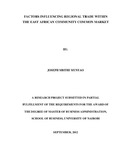| dc.description.abstract | The objective of this study was to find out the factors that influence regional trade within the East African Community common market. The population of interest consisted of the respective ministries responsible for the EAC affairs in all the member states of the east African common market. At the time of research there were only five member states which had ratified the EAC protocol, although Sudan, South Sudan and Somalia had applied to the secretariat for consideration as members of EAC. Results of the study show that the major benefits accruing to the member states from the EACCM include wider choice of goods and services afforded to the consumers, larger production base, expanded market size for producers and greater competitiveness and quality of products. The major factors influencing regional trade were identified as: industrial concentration within the member states, supply-side constraints and competition, multiple memberships, different tax regimes and non-tariff barriers. The industry concentration was found to be a little skewed with most members indicating that Kenya had higher concentration of industries with limited specialization by member states to produce what they have comparative advantage on. The main supply-side constraint identified was poor infrastructure which posed challenges by way of transportation, telecommunication and delays. However, it was also noted that the infrastructure problem only posed a challenge to a moderate extent to the regional trade. It was clearly established that regional trade within EAC does not receive a boost from multiple memberships and that EAC member states have delayed in harmonizing their tax regimes and this affect regional trade in EAC moderately. Regarding non-tariff barriers, it was found that NTBS still exist in the EAC common market to some extent. It was also found that there are mechanisms to deal with errant member states that enforce NTBS but that these mechanisms were only moderately effective. In conclusion the benefits of regional integration within the EACCM are more than the constraints experienced and it was suggested that the leveled of integration should be fast tracked to a federation | en |

